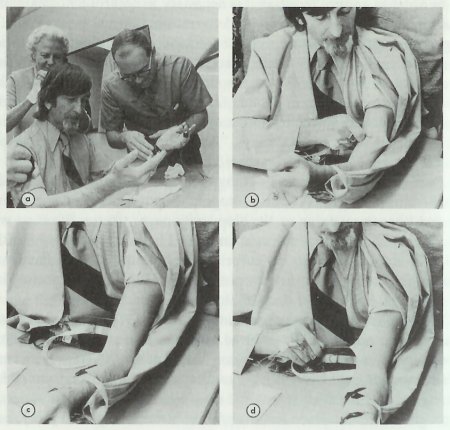
Excerpted from Beyond Biofeedback, a record of Elmer and Alyce Green’s research on theta brainwave training, which they describe as an accelerated form of meditation.
When Jack Schwarz was in his early teens, he saw a stage hypnotist enter a self-induced trance and then push pins into his arm while he talked about the power of mind to control pain and bleeding. Jack had the normal response to pain until he saw that demonstration, and then, for no particular reason, he knew that he would be able to do the same thing. He got some pins and tried it, and sure enough he could turn pain off. What a conversation piece, he thought.
Jack said that at first he never tired of amazing his friends. He developed a cocky attitude, in spite of the fact that he had not had to develop his skills, but “woke up one morning and found all the diplomas were on the wall.” He could stop pain, stop bleeding, influence people through hypnosis, remove pains in other people by putting his hands on them and thinking about the pain going away, and could often “guess” other people’s thoughts precisely.
We did not make a focused effort to interrogate Jack when we began the laboratory work. As with Swami Rama, we asked him to tell us what he would like to demonstrate. Dale and Alyce wired him in the same way we prepared college-student subjects in other research. When he sat down in the experimental room he produced an envelope with two 6-inch steel sailmaker’s needles. He said he would push the needles through his biceps and demonstrate bleeding control.
Jack was wired to record the behavior or a number of physiological variables that gave indications of stress reactions: heart rate, breathing rate, galvanic skin response, skin temperature, and brain waves. While we were adjusting the equipment near him, one of the needles rolled off the board on which his hands were placed and fell to the floor. As I picked it up I realized that we had not sterilized the needles, and I asked if he wanted me to do anything about it. He said, “No, I often sterilize my needle by putting it on the floor and rolling it under my shoe.”

Before Jack began pulling the needle out of his arm, I decided that it would be useful for the record if it were demonstrated that Jack could bleed in a normal way. It had occurred to me that otherwise, even if Jack repeated this demonstration a hundred times, we really would not know whether he had control of bleeding, or merely a peculiar skin condition.
In order to control bleeding, it is necessary to control a normally unconscious process. All yogis who demonstrate unusual powers of self-regulation apparently have achieved a kind of coordination between conscious and unconscious. In effect, I decided to interfere with that coordination. Just as Jack was preparing to pull the needle out of his arm, I interrupted him and said, “Jack, tell me, is it going to bleed now?” He looked quite surprised and uncertain, like a man balancing on one finger when someone said, “Are you going to fall now?”
Jack said, “I don’t think it’s going to bleed.” But when he pulled the needle out, it bled freely. The photographer put down his camera, and he and I began mopping up the blood with paper tissues. Bleeding was continuous for about ten seconds, and then I heard Jack say very softly, “Now it stops.” Much to my surprise, the hold in the skin that I was dabbing closed up as if drawn by purse strings. It took about one second to close, and not another drop of blood appeared.
We were very much impressed, and I said to Jack, “I am glad to see that you are normal and can bleed, and can also stop bleeding. How about doing it again, but this time don’t bleed at all.” There was a pause. Many seconds went by, and I began to wonder if I had said something wrong, when Jack said, “Okay, I’ll do it again.” He pushed the needle through a different place in his arm, and allowed it to remain buried in the muscle for a half minute or so. Though I squeezed his arm, no blood came out when the needle was removed.
When the test was concluded we talked for awhile, and I asked Jack why he had paused so long before he agreed to do the second demonstration. He said he wanted me to understand that he did not force his body to do any of these things. He asked it to. He had to ask his subconscious and want for an answer. When it said “Yes” to him, he said “Okay” to me.
Faith, Hypothesis and Transcendental Knowledge
Attitude is a critical feature in biofeedback training, because volition is influenced by what one believes (although the psycho-physiological principle itself is entirely independent of what people do or do not believe). This fact was first brought to our attention by John Seaman Garns, who phrased it, “Mind operates under its own conception of itself.”
The average person was in a bind until the advent of biofeedback training. Consider some examples. One woman, who with the help of a biofeedback machine was learning to warm her hands, asked, “Do you have to have faith to operate this machine?” Our answer was that to begin with faith was totally unnecessary, because the machine is a faith enhancer. No more faith is required to learn to operate it than to learn to drive a car. We do not have to believe or have faith that the car will turn to the left if we turn the steering wheel to the left. All that is necessary is to try it. Then we know.
There seems to be a hierarchy of effectiveness of psychological states with respect to self-regulation of physiological processes. The hierarchy might be arranged as follows: to hope, to hypothesize, to believe, to know—and biofeedback makes it possible to leap the entire distance at once.
This is a common attribute of Tangki in Taiwan and Singhapore when they are possessed by a god. When the skin is pierced it doesn’t bleed. They’ll put skewers all up and down their back. When the tongue is pierced it does bleed, the blood pours onto paper talisman which are then distributed to devotees.
The biofeedback demonstrates that this aspect of the autonomic nervous system is not necessarily autonomic (at least some of us can control it, it’s just different from the feeling of control we have over muscles.)
I’m enjoying the endocrine system explanation. Evolutionarily speaking, there are times when we might be sliced open but also be in desperate need of escape. Once in relative safety we bleed, which cleans the the wound and allows clotting to take place gradually.
There are many questions. If this is true then what are the decisive factors? Do we have to be “worked-up” in just the right way in order to not bleed? Do we also have a “let’s get this over with quickly” bleed out faster endocrine response? What are the side effects?
There are also case where tranced or possessed individuals show no burns after placing glowing hot metal to skin and their tongues.
With piercing you can squeeze just right and the capillaries seal and there is no blood unless you got a vein, but you can’t do this with heat. The needle pierces with skin and causes no bleeding trick is little more than a trick, but some cases of trance and possession related phenomena cannot be explained well.
Trance and possession are apparently not required.
Jack Schwarz performed a similar demonstration in front of a group of Los Angeles doctors. He grabbed two burning coals out of a fire with his bare hands, and walked them around the group for inspection. Afterwards, he placed them on a newspaper, which immediately caught fire.
The doctors were upset by his impudence, and by the absence of any damage to his hands.
The doctors were upset by his impudence, and by the absence of any damage to his hands.
I love it!
I think it is mind over matter, but I have not played with hot things like that.
This actually inspired an article I wrote over at Martial U. Do you think training to learn to do things like Mr. Schwarz would be beneficial to martial artists, or do you think it would be a waste of time?
Do you even believe you can learn stuff like that? When I talk about things like that to most people they tend to suggest it’s just a lot of creative trickery.
The ‘needle and no bleeding trick’ was talked about by Hatsumi in one of his books maybe 2 decades ago. He also talked about broken glass tricks and others things that are used to convince others of powers that don’t exist.
How can these things help someone master self or defend self?
I think that in most cases they cannot and are often used to bedazzle people into thinking that there is a mystical component to things that actually lack them.
Understand that Jack Schwarz did not set out to control his bleeding. That is merely one fruition of self-awareness–a capacity that is absolutely, positively beneficial to everyone, including martial artists.
Anyone can benefit from meditative practice. The way to confirm this is not to ask the uninformed, but simply to try it yourself.
Such demonstrations are an effect, not a cause.
I think that in most cases, martial artists who cannot do any of these things will try to bedazzle others with kicks and punches instead, which is a shame.
I think that in most cases, martial artists who cannot do any of these things will try to bedazzle others with kicks and punches instead, which is a shame.
Any so called martial artist who attempts to bedazzle is a fool, regardless of how they attempt it. Martial arts is not about being the center of attention, unless you write a blog!! (don’t we all?)
The bleeding tricks are great attention grabbing methods. but anyone can learn them, it has nothing to do with martial arts. Instruction for how to do the one with the needle is not uncommon.
“All warfare is based on deception,” according to Sun Tzu.
If you take away everything that has nothing to do with martial arts, then you will be left with nothing at all.
Sometimes the “common” stuff is fun, but there is nothing like throwing a good fireball mid-demo to bring the crowd to their feet.
Ash is a good insulator, I wonder if the guy who put hot coals in his hand put down a bed of ash first. That would probably do the trick.
Coincidentally I just got done writing an article about scientific research in the study of the mind in relation to meditation (and traditional training).
Your article got me thinking about some of the more physical manifestations of that mental growth.
A lot of this research that you’ve posted seemed quite popular a few decades ago, but recent research seems hard to come by. I know they’re doing some testing at UCI, but are you aware of any other research that’s ongoing?
Research on what? Biofeedback?
Biofeedback, mind-body control, throwing fireballs…
I don’t really follow that stuff. Much of what has appeared on this blog is a matter of sheer coincidence, or synchronicity.
Thanks for submitting this post to our blog carnival. We just published the 47th edition of Brain Blogging and your article was featured!
Thank you.
Sincerely,
Shaheen
Very smart.